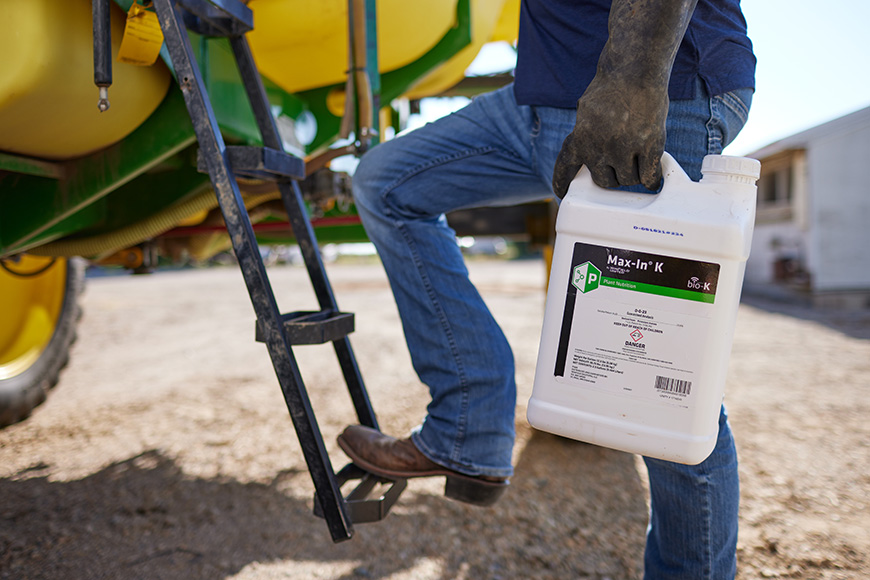Don’t Short Micronutrients in Your Plant Nutrition Plan

Micronutrients are a critical part of an effective fertility plan. Even though they’re used in a more nuanced way than macronutrients, they still play a significant role in plant growth and development, which can help you achieve greater return on investment (ROI) and yield potential in your corn and soybeans. As you finalize your inputs for next season, consider how micronutrients should factor into your overall nutrient strategy.
Don’t Have The Perfect Soil? You Still Need A Plan
On acres with suboptimal yield potential, you may be more conservative with your inputs, but it’s still important to invest in micronutrients. With marginal-producing acres, I recommend doing a baseline nutrient application for crop removal using production history or any past in-season indicators.
Success with these types of acres isn’t about putting a flat layer of nutrients over them and calling it good. It’s about dialing in to the performance of each acre to help optimize ROI potential. Discover zones within each field to set the stage using macronutrients as primary components. Then, dial in opportunities through crop scouting and tissue sampling to use micronutrients for optimizing overall yield potential.
Get Nutrient Application Timing Right
All 17 macronutrients and micronutrients are essential to crop growth and production. But remember, the right nutrient needs to be used on the right crop at the right time. Work with your agronomist to prepare a comprehensive nutrient plan that allows you to target nutrient applications when the plant can use it the most.
For example, the most optimal time to apply foliar potassium (K) is during reproductive growth stages. Typically, this means applying a product like MAX-IN® K along with your tassel fungicide. NutriSolutions® tissue test results from 2024 show K deficiencies in 79.2% of R1-R5 soybean samples and 51.1% of R1-R4 corn samples.1 Providing an extra nutritional boost to meet some of that K demand at fungicide timing has been shown to help with later season grain fill and nutrient uptake.
According to WinField® United tissue sampling reports, zinc, manganese and boron are the most common micronutrient deficiencies in corn and soybeans.2 While required in smaller amounts, these nutrients are just as critical as macronutrients. With MAX-IN Ultra ZMB® Plus micronutrient, you can address all three deficiencies in one application.
The most optimal timing to apply MAX-IN Ultra ZMB Plus on corn is during early vegetative stages (V5-V10). Years of tissue testing data prove this is the best chance for seeing a yield response to the zinc application found in MAX-IN Ultra ZMB Plus. Its manganese and boron components allow it to flex into responding to those nutrient deficiencies and other application timings as well, such as V18-R2. The combination of these three micronutrients allows plants to move more nutrients into growing points, maximize photosynthetic capacity and transport sugars where they are needed.
Get The Right Micronutrients To The Target
Nutrient deficiencies can limit a crop’s ability to develop to its full potential, but holes in your crop’s nutrition may be mitigated by proactively developing a plan for next season.
After reviewing in-season tissue sampling and end-of-year soil sampling results with your trusted advisor, find the right micronutrient products to correct any deficiencies on your priority acres. WinField United offers three key micronutrient product lines to address your plant nutrition needs.
-
Lignosulfonates: These are dry products that can be applied in a broadcast, strip-till or sidedress manner. Lignosulfonates are naturally occurring compounds derived from plant material. Micronutrients are complexed with lignosulfonates to create a granular product for soil application that helps improve mobilization and nutrient uptake for the plants.
-
MAX-IN micronutrients: These foliar-applied products are used for in-season nutrient management and can be tank mixed with herbicides, insecticides and fungicides. MAX-IN products contain patented CornSorb® technology to greatly increase the movement of micronutrients through the leaf cuticle and into internal structures.
-
Liquid chelated products: These are typically used for in-furrow or liquid sidedress applications to help increase nutrient efficiency and availability to crops. WinField United offers Citri-Che® micronutrients, which are chelated with citric acid and EDTA, and Ultra-Che® micronutrients, which are fully chelated with EDTA or HEDTA. The chelators in Ultra-Che micronutrients help provide strong, reliable protection against micronutrient soil tie-up.
Products in the WinField United micronutrient portfolio have been tested through the Answer Plot® program as well as on-farm, which together provide WinField United with the best opportunity to position the proper product on your acres. Testing at the WinField United Innovation Center also offers assurance of product integrity and favorable tank mixability, as well as greenhouse analysis of performance.
What To Do In The Spring
If you took tissue samples this season, review test results with your agronomist to determine what nutrient needs you may have to tackle in 2026 and when. If you don’t have tissue samples from your farm talk with your local retailer about accessing a tissue sample data set from your area to find out what micronutrient deficiencies might be evident in your geography.
1Data from internal WinField United research.
2Average based on 221,050 tissue samples from the WinField United Tissue Sample Treasury across V4-R2 growth stages from 2012-2022.
All photos are either the property of WinField United or used with permission.
© 2025 WinField United. Important: Before use always read and follow label instructions. Crop performance is dependent on several factors many of which are beyond the control of WinField United, including without limitation, soil type, pest pressures, agronomic practices and weather conditions. Growers are encouraged to consider data from multiple locations, over multiple years and to be mindful of how such agronomic conditions could impact results. Answer Plot, Citri-Che, CornSorb, MAX-IN, NutriSolutions, R7, Ultra-Che and WinField are trademarks of WinField United. All other trademarks are the property of their respective owners.





